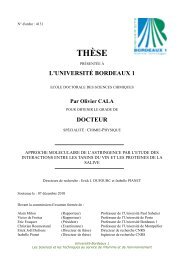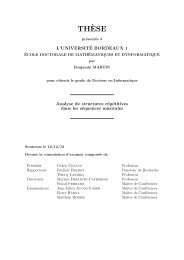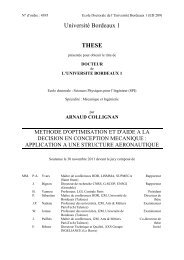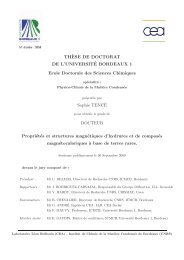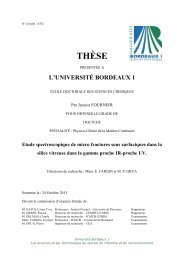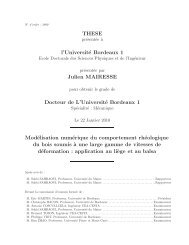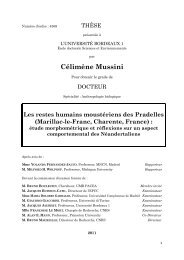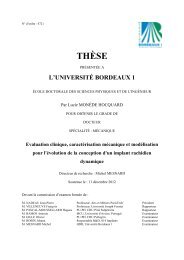de la structure à la croissance cellulaire - Université Bordeaux 1
de la structure à la croissance cellulaire - Université Bordeaux 1
de la structure à la croissance cellulaire - Université Bordeaux 1
You also want an ePaper? Increase the reach of your titles
YUMPU automatically turns print PDFs into web optimized ePapers that Google loves.
120 M. Bourdon et al.<br />
transition in p<strong>la</strong>nt cells is exerted through the retinob<strong>la</strong>stoma-re<strong>la</strong>ted protein (RBR)<br />
pathway (<strong>de</strong> Jager and Murray 1999; Gutierrez et al. 2002), where the hypophosphory<strong>la</strong>ted<br />
form of RBR binds to the E2F-DP dimeric transcription factor, thereby<br />
repressing the E2F-responsive genes required for the commitment to the S-phase,<br />
such as those encoding the pre-RC components. Interestingly, the ectopic expressions<br />
of either CDC6 (Castel<strong>la</strong>no et al. 2001) or CDT1 (Castel<strong>la</strong>no et al. 2004), or E2Fa<br />
with its dimerization partner DPa (De Veyl<strong>de</strong>r et al. 2002) are sufficient to trigger<br />
extra endocycles, as well as the inhibition of RBR function, consistent with the<br />
inhibitory function of RBR on E2F (Park et al. 2005). It is noteworthy that the<br />
activation of DNA replication in all these transgenic p<strong>la</strong>nts results in extra endocycles<br />
and also causes prolonged cell proliferation activity. These data illustrate the conservation<br />
of molecu<strong>la</strong>r controls between the endocycle and the canonical cell cycle, but<br />
more importantly the importance of regu<strong>la</strong>ting the CDK activity, including the<br />
pivotal role of MIF at the onset of endoreduplication. It was thus proposed as a<br />
quantitative mo<strong>de</strong>l that the amount of CDK activity controls the differentiation – and<br />
obviously the endoreduplication – status of a cell (De Veyl<strong>de</strong>r et al. 2007).<br />
5.2.3 Regu<strong>la</strong>tion of CDK Activity in Endoreduplication During<br />
Fruit Development<br />
Among the potential mechanisms regu<strong>la</strong>ting the CDK activities in endoreduplicating<br />
tissues, three distinct mechanisms are proposed to be affecting the components<br />
of the CDK/CYC complexes at the posttrans<strong>la</strong>tional level: (1) the WEE1<br />
kinase regu<strong>la</strong>tes negatively the CDK activity by phosphory<strong>la</strong>tion of residue Tyr15<br />
before the commitment to mitosis as to ensure that DNA replication and repair on<br />
damaged DNA have been completed; (2) the active CDKA/CYCD complexes may<br />
be inhibited by specific CDK inhibitors, termed ICK/KRPs (for Interactor of cyclin<strong>de</strong>pen<strong>de</strong>nt<br />
kinase/Kip-re<strong>la</strong>ted protein); (3) loss of CDK activity occurs upon the<br />
proteolytic <strong>de</strong>struction of the cyclin subunits via the ubiquitin proteasome pathway,<br />
involving the activation of the anaphase-promoting complex (APC) through its<br />
association with the CCS52.<br />
Since endoreduplication p<strong>la</strong>ys such an important part during fruit <strong>de</strong>velopment<br />
(Chevalier 2007), the re<strong>la</strong>tive contribution of these different control mechanisms on<br />
CDK activity has been addressed in tomato.<br />
Role of WEE1<br />
Homologues to WEE1 have been iso<strong>la</strong>ted from various p<strong>la</strong>nt species (Shimotohno<br />
and Umeda 2007). While functional analyses performed in Schizosaccharomyces<br />
pombe indicated that expression of the maize or Arabidopsis gene led to the inhibition<br />
of cell division and significant cell en<strong>la</strong>rgement (Sun et al. 1999; Sorrell et al. 2002),<br />
Arabidopsis knock-out mutants for WEE1 grow perfectly well un<strong>de</strong>r nonstress conditions<br />
(De Schutter et al. 2007). Neither cell division nor endoreduplication was<br />
affected in these mutants, thus indicating that WEE1 is not rate-limiting for cell cycle



